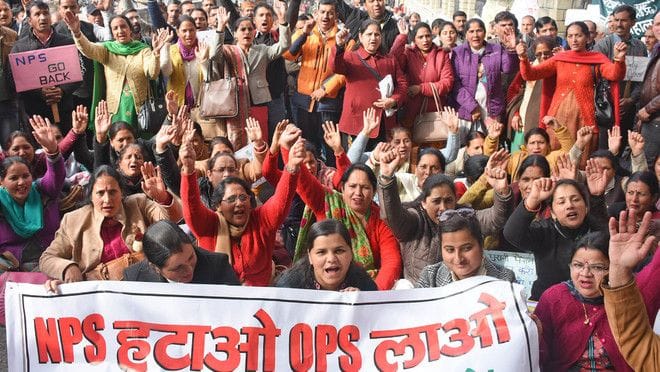Some political parties are making old pension
scheme as their agendas for elections, Is OPS really
better than NPS?
NPS (THE OLD PENSION SCHEME)
The old pension scheme ensured that pensioners received a fixed monthly payout, which kept increasing with the dearness allowance.
But this scheme has some major disadvantages that are disasters for the Indian economy.
DRAWBACKS OF THE OLD PENSION SCHEME(OPS)
The primary disadvantage of this pension system is that it takes up a significant portion of a State’s financial resources. According to the Official Journal of the Union, 56 per cent of the State’s revenue was allocated for the purpose of providing pensions and salaries to government employees. In the State of Rajasthan, 23,000 Crores were allocated for pensions, while 60,293 Crores were spent on salaries.
The other major disadvantage is that the funds are not coming from a pension fund, but rather from taxes collected by the State. The third disadvantage is that the money being allocated to pensions is not yielding any returns.
FINANCES OF THE OLD PENSION SCHEME(OPS)
In 2021, the number of pensioners in India was around 6.9 million, and the total amount spent on pensions was around Rs 3.86 lakh crore. As inflation goes up, the government gives more money to the pensioners, but the rest of the burden falls on the people who are already paying taxes.
Back in 1991, the pension bill of the center was Rs 3,272 crore, and the total outgo for all the states was Rs 3,131 crore. But by 2021, the bill of the center had gone up by 58 times to Rs 1.9 lakh crore, and the states’ outgo had gone up by 125 times to Rs 3.86 crore. Some state governments are spending more on pensions than on development.
HOW DOES IT AFFECT STATE FINANCES?
The RBI has reported that the three states Punjab, Uttar Pradesh and Bihar are spending so much money on pensions that the central government is contributing more to their economies than they are to theirs. The central government contributes 42.7% to Punjab’s economy, 52.1% to Uttar Pradesh’s economy, and 75% to Bihar’s economy. This is worrying because the governments and politicians have promised to go back to the old pension system if this happens. If the central government goes bankrupt, it could cause a Sri Lanka-style crisis in the country.
LACK OF PLANS
The state governments don’t have a clear plan on how they’re going to pay out pensions from the old pension system. This means that some states are spending too much money on pensions and not enough on other things like development. Gujarat and Maharashtra are the two states that are spending the most on pensions – 15.33%, 12.98%, respectively. Meanwhile, Bihar is spending 58.9%, Punjab is spending 34.24%, and so on. You can see how these states are doing.
THE NEW PENSION SCHEME(NPS)
The National Provident Fund (NPS) was introduced in 2009 by the former Prime Minister Alal bihari vaajpeyi to enable individuals to plan for their retirement while employed. For example, if an employee’s salary is Rs 10,000 per month and they contribute Rs 1,000 to their retirement fund, the government will add Rs 1,000 each month. As long as the employee is employed, their money is still working as the money deducted from their salary is being utilised by the organization to invest in equities, corporate debt, and government bonds. Furthermore, subscribers have the option to withdraw up to Rs 60,000 in a lump sum while the remainder can be utilised as part of a regular annuity plan.
WHY ARE FEW GOVERNMENTS SUPPORTING OPS?
The state governments of Rajasthan, Chhatisgarh and Jharkhand, as well as the Punjab government in Himachal Pradesh, have decided to use OPS. It’s convenient for them since they can pay old pensioners out of the money they get from serving employees. Under OPS, the employees don’t have to pay anything into their pensions, which means they get more money in their paychecks every month. It’s a simple system, so the government is using it to get more votes.
CONCLUSION
NPS is designed to encourage citizens to save for retirement and to use taxpayers’ money for growth. The new scheme provides subscribers with a variety of investment options, as well as flexibility, portability and transparency. This makes NPS an appealing retirement savings solution for individuals. However, there are some limitations and risks associated with the scheme, including the absence of guaranteed returns and the potential for market risks. Nevertheless, the advantages and tax advantages of NPS make it a suitable long-term investment solution.






